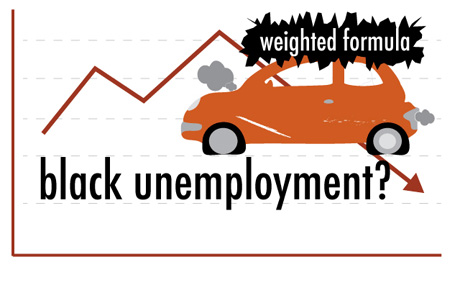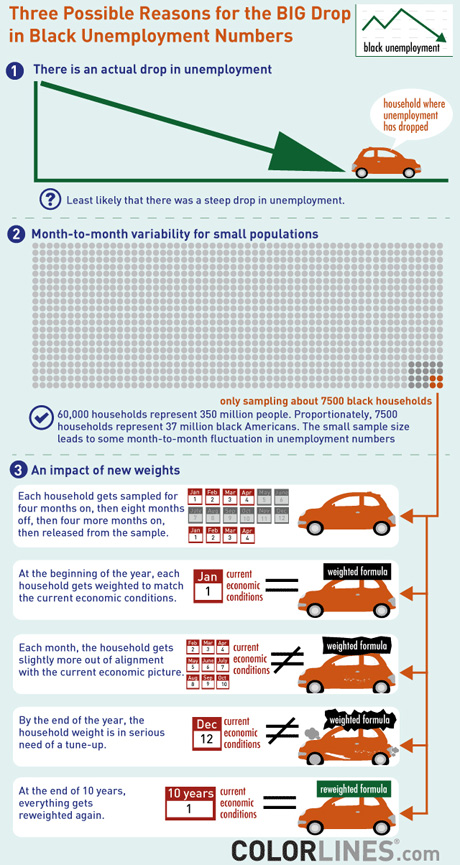
When the black unemployment numbers dropped so steeply in January—from 15.7 to 12.7 percent—a lot of analysts were scratching their heads to figure out why. One told us that it was “quite surprising,” but there would be no way to know what the numbers meant or whether they were accurate until we saw if the trend continued in later months. But why is that? Aren’t these numbers hard and fast facts? We dug a little deeper into the process of tracking joblessness to find out. Put on your data nerd hat and follow along.

We learned two important things. First, it’s confusing. Second, it’s difficult to know each month if the latest numbers bandied about on newscasts are as accurate as we think they are. When unemployment numbers fall, like they did so dramatically with black workers last month, any one of three factors could be driving that change—and it’s difficult to know which one is really making the difference. Colorlines.com graphic designer Hatty Lee has mapped out the three factors visually below, but here’s the detailed explanation of each option.
1) An actual reduction in unemployment. This is the ideal, but since it’s unlikely that unemployment would fall by three points for the black population in a single month, real employment is not likely the only thing that it explains it.
2) Month-to-month variability for smaller populations. Unemployment for blacks has hovered around double the rate of whites for decades. But the numbers tend to fluctuate a bit more for black workers, because of the way joblessness is tallied. To get the nation’s unemployment data, researchers select 60,000 households representing 350 million people. Of that 60,000, the proportional sample of black households is about 7,500. That’s a fairly small number within the larger sample, and the smaller the sample, the more likely it is to fluctuate dramatically.
2) The impact of new weights. This is where it gets complicated. Each household is sampled for four months, then ignored for eight months, then sampled for four more months, and then released from the sample. And each household is given a different formula weight, depending on a wide range of factors, including the identity of the household and the larger socio-economic picture.
So, think of each household like a car. These weights stay the same for a year, and then at the end of the year, the households are reweighted to reflect the more current economic climate. If each household is like a car, then over the course of a year, every month the numbers get slightly further out of alignment—because the weights stay the same from January to December even as the broader economic picture changes. By the end of the year, the car needs a tune-up, which is when the Bureau of Labor Statistics re-weights the household.
This means that the decline in unemployment from January 2011 to December 2011 is most likely to be a misreading, because the households sampled in December are using the same weights as the January households—even though the weights in December are now far out of alignment with the larger economic picture.
Secondarily, at the end of each 10 year Census, the BLS does another re-weighting. If the January numbers were calculated under new weights, and the December numbers were calculated under the old weights, then calculating the December numbers under the new weights could show a less steep drop in unemployment.
Most importantly, however, what we’ve learned is that there’s really no way to tell what’s going on until a few more months have passed.
Reprinted with permission of Colorlines.com. Sign up to receive Colorlines Direct, a weekly email digest of key stories on Colorlines.com. You’ll get award-winning news from our multi-racial team of writers covering hot topics and a broad range of issues from a racial justice perspective.
Our most important fundraising appeal of the year
December is the most critical time of year for Truthout, because our nonprofit news is funded almost entirely by individual donations from readers like you. So before you navigate away, we ask that you take just a second to support Truthout with a tax-deductible donation.
This year is a little different. We are up against a far-reaching, wide-scale attack on press freedom coming from the Trump administration. 2025 was a year of frightening censorship, news industry corporate consolidation, and worsening financial conditions for progressive nonprofits across the board.
We can only resist Trump’s agenda by cultivating a strong base of support. The right-wing mediasphere is funded comfortably by billionaire owners and venture capitalist philanthropists. At Truthout, we have you.
We’ve set an ambitious target for our year-end campaign — a goal of $250,000 to keep up our fight against authoritarianism in 2026. Please take a meaningful action in this fight: make a one-time or monthly donation to Truthout before December 31. If you have the means, please dig deep.
